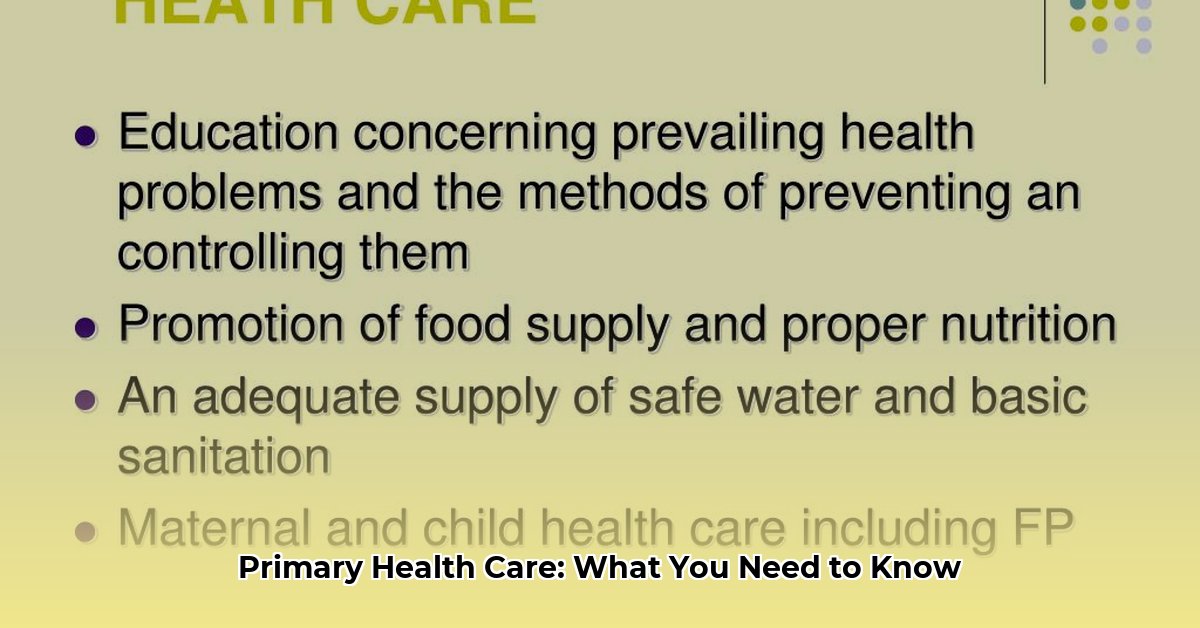Healthcare is not merely about treating illness; it’s about cultivating well-being. Primary health care (PHC) represents this holistic approach, encompassing interconnected services that cater to individual and community needs, supportive policies that promote healthy living, and the empowerment of individuals to take charge of their own health. This article delves into the three key components of PHC—services, policies, and community empowerment—illustrating how they contribute to healthier lives for all. We’ll explore real-world examples, analyze effective strategies, and examine the future of PHC, from local solutions to global impact.
Integrated Health Services
Imagine a healthcare system that views your physical health, mental well-being, and social context as interconnected elements. This is the essence of integrated health services. It’s a comprehensive approach where different services work together—vaccinations prevent diseases, maternal care supports healthy pregnancies, and chronic disease management helps individuals live well with conditions like diabetes or heart disease.
This integrated approach may likely lead to better health outcomes. For example, effectively managing diabetes can also mitigate the risk of heart problems. By connecting these services, healthcare providers offer more holistic and personalized care, potentially addressing multiple health needs concurrently.
Multisectoral Policies and Action
Good health extends beyond the confines of clinics and hospitals. Factors like our environment, diet, and education significantly influence our well-being. This is where multisectoral policy and action become crucial. This collaborative approach brings together diverse stakeholders—health officials, educators, environmental agencies, and urban planners—to work together on improving community health.
Safe housing, clean water, and nutritious food are all prerequisites for healthy living. Multisectoral initiatives might involve policies to improve sanitation, healthy food programs in schools, or community designs that encourage physical activity. Addressing these broad social determinants of health creates environments that support well-being for everyone. Some experts suggest this collaborative approach is essential for tackling complex health challenges and achieving lasting change.
Empowered People and Communities
Empowering people and communities provides individuals with the knowledge, skills, and resources they need to manage their own health. This approach fosters a sense of ownership and responsibility for well-being, rather than sole reliance on healthcare professionals. This can involve health literacy programs, community participation in health planning, and patient advocacy groups.
When residents actively participate in health initiatives, like community gardens or support groups, it fosters a sense of belonging and empowers healthy choices. This suggests that engaged communities are more likely to experience positive health outcomes and build resilience.
Benefits of Primary Health Care
Investing in robust PHC offers numerous benefits. It may likely lead to improved health outcomes, reduced health inequities, and more resilient health systems. Data suggests that strong PHC systems are associated with lower rates of preventable diseases and improved overall population health. By emphasizing prevention and early intervention, PHC can reduce the need for costly hospitalizations and specialized treatments, potentially contributing to a more equitable society.
Challenges to PHC Implementation
Implementing PHC is not without its challenges. Funding shortages, workforce limitations, and access in remote areas can present significant obstacles. Innovative solutions, such as community health worker programs and telehealth technologies, are being developed to address these challenges. Ongoing research is exploring the most effective strategies to overcome these barriers, and further investigation is needed.
Global Initiatives and the Future of PHC
Global initiatives, such as Universal Health Coverage, aim to ensure everyone has access to quality, affordable healthcare, aligning with PHC principles. The future of PHC will likely be influenced by emerging technologies like telehealth, AI, and personalized medicine. While the long-term impact is uncertain, ongoing research is exploring how these advancements can enhance access, improve diagnostics, and personalize treatments within PHC systems.
The Eight Essential Elements of Primary Health Care
The 1978 Alma-Ata International Conference on Primary Health Care established eight essential components of PHC, which remain foundational:
- Health Education: Educating communities about prevalent health problems, prevention methods, and control strategies.
- Nutrition: Ensuring adequate food supply and promoting healthy eating habits.
- Safe Water and Sanitation: Providing access to clean water and sanitation to prevent waterborne illnesses.
- Maternal and Child Health: Providing comprehensive maternal and child healthcare, including family planning services.
- Immunization: Protecting against major infectious diseases through vaccination programs.
- Local Disease Control: Preventing and controlling diseases prevalent in specific geographic areas.
- Treatment of Common Diseases and Injuries: Ensuring appropriate treatment for common illnesses and injuries.
- Essential Drug Provision: Guaranteeing access to necessary medications.
The Three Interconnected Components of Primary Health Care: A Deeper Dive
Primary health care (PHC) is a comprehensive approach to well-being, encompassing integrated health services, multisectoral policies, and empowered communities. These three interconnected components work synergistically to create a healthier future.
1. Integrated Health Services: Holistic and Connected Care
Integrated health services form the bedrock of PHC. This approach connects various healthcare services, ensuring seamless, comprehensive care throughout an individual’s lifespan. For instance, during a routine check-up, an integrated system might also address preventative care, chronic condition management, and lifestyle counseling. This holistic approach considers all aspects of an individual’s health.
2. Multisectoral Policy and Action: Addressing the Broader Determinants of Health
Multisectoral policy acknowledges that health is influenced by factors beyond healthcare settings, such as housing, environment, and education. This approach brings together diverse sectors to address underlying causes of poor health. For example, addressing food insecurity might involve urban planning to encourage grocery stores in underserved areas, supporting community gardens, and promoting nutrition education.
3. Empowered People and Communities: Fostering Ownership and Participation
Empowered communities are active participants in their own health. This involves equipping individuals with the knowledge and resources to make informed choices and advocate for their needs. Examples include community health workers leading workshops, resident involvement in health facility planning, and patient advocacy groups promoting better access to care.
Summary of Primary Health Care Components
| Component | Key Elements |
|---|---|
| Integrated Health Services | Vaccinations, maternal care, chronic disease management |
| Multisectoral Policy & Action | Sanitation policies, healthy food access, interagency collaboration |
| Empowered People & Communities | Health literacy programs, community participation in health planning, patient advocacy |
Conclusion: A Healthier Future for All
Primary health care is essential for building a healthier future. By supporting PHC initiatives, advocating for health equity, and actively engaging in our communities, we can help ensure everyone has the opportunity to live a long, healthy life. For further information, please consult the World Health Organization (https://www.who.int/).
- Weight Loss Supplements That Work and Those That Dont - October 31, 2025
- Male Eating Disorders Often Missed but Increasingly Prevalent - October 29, 2025
- Males With Anorexia Nervosa Have Distinct Symptoms and Treatment Needs - October 28, 2025










